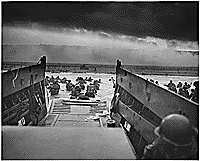Cross-Channel Invasion
The Invasion: D-Day

WWII: Europe: France; "Into the Jaws of Death - U.S. Troops wading through water and Nazi gunfire".
(NLR-PHOCO-7298) from NAIL database
Map of D-Day Invasion
D-Day served to demonstrate the will of the Allies. The second front was finally a reality. The invasion had to be won by the soldiers on the beach rather than by logistics, air supremacy, sabotage, or deception. (19) The invasion was preceded by false radio transmissions among other diversionary tactics. The air assault that preceded the beach landing was a disaster. Parachuters landed as far as35 miles from thier target site and many were shot to death before they landed. At dawn on June 6 1944, 5000 Allied ships began crossing the English Channel, headed for Normandy. The first troops disembarked from landing craft at 6:31 am on Utah beach. Ten miles east on Omaha beach 4,649 men died securing the beach. Gold, Juno, and Sword beaches were reached by British and Canadian troops who encountered much less resistance from the Germans and from the terrain. Within a day, forces combined and moved further into France. (20)
 Six weeks after the invasion, the Allies had moved only twenty miles inland. However, the cross-channel invasion was the result of years of planning, conferences, and correspondence. The relationship between FDR and Churchill was strained at times, but the end result, the German surrender, is evidence that their relationship certianly aided in victory. The relationship ended on April 12, 1945, when FDR's frial body succumbed to death. Churchill had once told him, "It is fun to be in the same decade as you." Their friendship was intimate and personal, as well as essential to victory.
Six weeks after the invasion, the Allies had moved only twenty miles inland. However, the cross-channel invasion was the result of years of planning, conferences, and correspondence. The relationship between FDR and Churchill was strained at times, but the end result, the German surrender, is evidence that their relationship certianly aided in victory. The relationship ended on April 12, 1945, when FDR's frial body succumbed to death. Churchill had once told him, "It is fun to be in the same decade as you." Their friendship was intimate and personal, as well as essential to victory.
WWII: Europe: France; "U.S> Troops
land at Normandy". (NLR-PHOCO-7420(1298))
from NAIL Database
| >
Table of Contents


 Six weeks after the invasion, the Allies had moved only twenty miles inland. However, the cross-channel invasion was the result of years of planning, conferences, and correspondence. The relationship between FDR and Churchill was strained at times, but the end result, the German surrender, is evidence that their relationship certianly aided in victory. The relationship ended on April 12, 1945, when FDR's frial body succumbed to death. Churchill had once told him, "It is fun to be in the same decade as you." Their friendship was intimate and personal, as well as essential to victory.
Six weeks after the invasion, the Allies had moved only twenty miles inland. However, the cross-channel invasion was the result of years of planning, conferences, and correspondence. The relationship between FDR and Churchill was strained at times, but the end result, the German surrender, is evidence that their relationship certianly aided in victory. The relationship ended on April 12, 1945, when FDR's frial body succumbed to death. Churchill had once told him, "It is fun to be in the same decade as you." Their friendship was intimate and personal, as well as essential to victory.